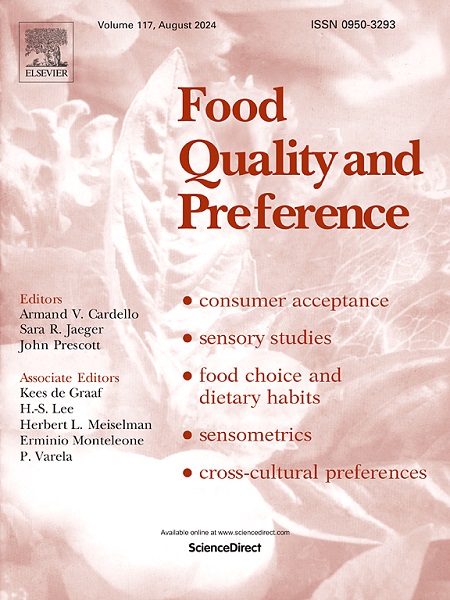Liking for saltiness is associated with preference for fattier and more caloric foods
IF 4.9
1区 农林科学
Q1 FOOD SCIENCE & TECHNOLOGY
引用次数: 0
Abstract
The high consumption of foods rich in salt, fat and sugar represents a risk factor for adverse health outcomes, and while strategies for the reduction of these ingredients have been developed, results have been inconclusive. One reason for this may be that the relationship between preferences for salty, fat and sweet foods is unclear. The aim of this study was to investigate whether individuals showing a higher liking for salty foods also prefer fattier foods, whether savoury or non-savoury/sweet. Liking and intensity responses for a model food (bean purée with increasing concentrations of salt, NaCl, added) were provided by 395 subjects to identify groups of consumers with different responses to saltiness.
Hierarchical cluster analysis based on liking scores revealed that one group of subjects (Cluster 1: Salt likers, n = 285) liked the bean purée samples with higher NaCl concentrations significantly more than did those belonging to Cluster 2 (Salt dislikers, n = 110). Salt dislikers also rated saltiness, umami taste, and overall flavour as significantly more intense than did salt likers. These differences were also present in assessment of tastes in water solutions, while no differences between clusters in fungiform papillae density and in attitudes toward health and taste were found. Significant differences between the two clusters were found in terms of food choices, with salt likers choosing foods – both savoury and non-savoury/sweet – that are fattier, more caloric, and thus perceived as less healthy, more frequently than did salt dislikers.
These results suggest that subjects preferring saltier foods generally also prefer fattier foods, whether savoury or not-savoury. Thus, the approach of segmenting individuals on salty taste preferences appears to be a useful way of identifying consumers groups more prone to make less healthy food choices in general.
喜欢咸味与喜欢吃脂肪和热量较高的食物有关
大量食用富含盐、脂肪和糖的食物是导致不良健康后果的一个风险因素,虽然已经制定了减少这些成分的策略,但结果并不确定。其中一个原因可能是人们对咸味、脂肪和甜味食物的偏好之间的关系并不明确。本研究的目的是调查对咸味食品有较高喜好的人是否也喜欢脂肪含量较高的食品,无论是咸味食品还是非咸味/甜味食品。395名受试者提供了对模型食品(添加盐浓度(NaCl)不断增加的豆泥)的喜欢程度和强度反应,以确定对咸味有不同反应的消费者群体。基于喜欢程度得分的层次聚类分析显示,一组受试者(聚类1:喜欢吃盐的人,n = 285)对NaCl浓度较高的豆泥样品的喜欢程度明显高于属于聚类2的受试者(不喜欢吃盐的人,n = 110)。不喜欢吃盐的人对咸味、鲜味和整体风味的评价也明显高于喜欢吃盐的人。这些差异也出现在对水溶液味道的评价中,而在真菌乳头密度以及对健康和味道的态度方面,各组间没有发现差异。在食物选择方面,两个群组之间存在显著差异,喜欢吃盐的人比不喜欢吃盐的人更经常选择脂肪含量更高、热量更高的食物(包括咸味和非咸味/甜味食物),因此被认为更不健康。因此,根据个人对咸味的偏好对其进行细分的方法似乎是一种有用的方法,可以识别出更容易做出不那么健康的食品选择的消费者群体。
本文章由计算机程序翻译,如有差异,请以英文原文为准。
求助全文
约1分钟内获得全文
求助全文
来源期刊

Food Quality and Preference
工程技术-食品科技
CiteScore
10.40
自引率
15.10%
发文量
263
审稿时长
38 days
期刊介绍:
Food Quality and Preference is a journal devoted to sensory, consumer and behavioural research in food and non-food products. It publishes original research, critical reviews, and short communications in sensory and consumer science, and sensometrics. In addition, the journal publishes special invited issues on important timely topics and from relevant conferences. These are aimed at bridging the gap between research and application, bringing together authors and readers in consumer and market research, sensory science, sensometrics and sensory evaluation, nutrition and food choice, as well as food research, product development and sensory quality assurance. Submissions to Food Quality and Preference are limited to papers that include some form of human measurement; papers that are limited to physical/chemical measures or the routine application of sensory, consumer or econometric analysis will not be considered unless they specifically make a novel scientific contribution in line with the journal''s coverage as outlined below.
 求助内容:
求助内容: 应助结果提醒方式:
应助结果提醒方式:


